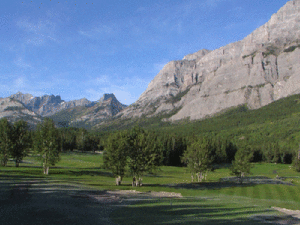Alberta
Alberta is one of the western provinces of Canada. Established in 1905, it is located to the north of Montana between the provinces of British Columbia and Saskatchewan. A majority of its population (3,455,062, 2007 est.) live in one of Alberta's two major cities, Calgary and Edmonton.
History
The province of Alberta was formed out of the Northwest Territories on September 1, 1905 and named for Louise Caroline Alberta, a daughter of Queen Victoria. Prior to this the area that now comprises Alberta was inhabited by various native American groups like the Blackfoot and Chipewyan among others. After the arrival of European settlers, marriages between the pioneers and native women gave rise to the Métis.
The first European known to have arrived in Alberta was fur trader Anthony Henday who arrived in the area around 1754 to hunt and trade with the natives. Fur traders and explorers soon arrived in greater numbers, having an impact on the lifestyles of many of the native tribes in the area. Later explorers like David Thompson, contributed to the knowledge of the geographical layout of Alberta when he prepared accurate maps while surveying the land for the North-West Company.
Early on in the 19th century the Hudson's Bay Company took control over the area that is now Alberta after it merged with the North-West Company. Settlers were initially prevented from entering Alberta although some missionary work was allowed. Various missionary sites would later become towns and cities. The first mission post to be set up was at Fort Edmonton, founded as a Methodist missionary in 1840.
In 1870, three years after Confederation, the Hudson's Bay Company transferred control over its land holdings to the government of Canada and two years later the area would be opened for settlement. Law enforcement was given a boost in 1873 with the creation of the North-West Mounted Police and the first NWMP post was established a year later at Fort Macleod. In 1875 the future city of Calgary was established as an NWMP post as well.
In the early 1880s Alberta's population began booming due to the arrival of the railroads in 1883 making settlement of the land feasible. An influx of ranchers to the foothills region and, to a lesser extent, farmers on the prairies meant a 17 fold growth in population from a scant 1.000 in 1880 to more than 17.000 people in 1890. By the 1920s Alberta had a population in excess of half a million, due in part by a drive to lure European immigrants to the area around the turn of the century.
On September 1, 1905, the District of Alberta and part of the District of Athabasca were merged to form the province of Alberta. A ceremony in Edmonton, the capital city of the newly formed province, was attended by prime minister Sir Wilfrid Laurier and the Governor General of Canada, Earl Grey.
The Liberal government appointed Frederick Haultain to be Alberta's first premier, starting a series of political dynasties that have dominated Alberta politics ever since. After the Liberals were swept from power in the 1921 provincial elections the government was formed by the United Farmers of Alberta, an agricultural cooperative, which remained in power until the Social Credit Party won office in 1934. Since 1971 the provincial government has been formed by the Progressive-Conservative Party.
The Great Depression was especially damaging to Alberta where many farmers lost their businesses due to falling wheat prices and droughts which, in the 1930s, caused much soil erosion similar to that in the United States during the dust bowl era. By 1947 however, the economic fortunes of Alberta were reversed when an oil deposit was discovered near Leduc, sparking a boom that, with interruptions, continues to this day. The emerging oil industry turned Edmonton and especially Calgary into prosperous cities. In 1988 Calgary hosted the Olympic winter games.
In recent years Alberta has been shaped by a large population influx and fast growing economy, mainly fueled by higher oil prices which are attracting people from other parts of Canada as well as overseas.
Geography
Alberta is one of Canada's Prairie Provinces, bounded on the west by the Rocky Mountains. Banff National Park is located in this region and remains Canada's oldest national park.
Government
Provincial politics in Alberta has traditionally been dominated by the ruling Conservative party. Alberta's first female leader and current premier Alison Redford was elected in October of 2011.
Oil and gas
Alberta has long been Canada's principal producer of oil and gas, sparked by the Leduc Oil Field discovery. Alberta rich oil fields are part of the vaster Western Canadian Sedimentary Basin, stretching from British Columbia to Manitoba, as well as parts of Montana and North Dakota. [1]
With conventional reserves dwindling, development has shifted to the Athabasca Oil Sands, one of the world's largest oil reserves.
References
- ↑ Oil Sands in Saskatchewan (PDF). Saskatchewan Industry and Resources, Government of Saskatchewan. Retrieved on 2008-02-06.
